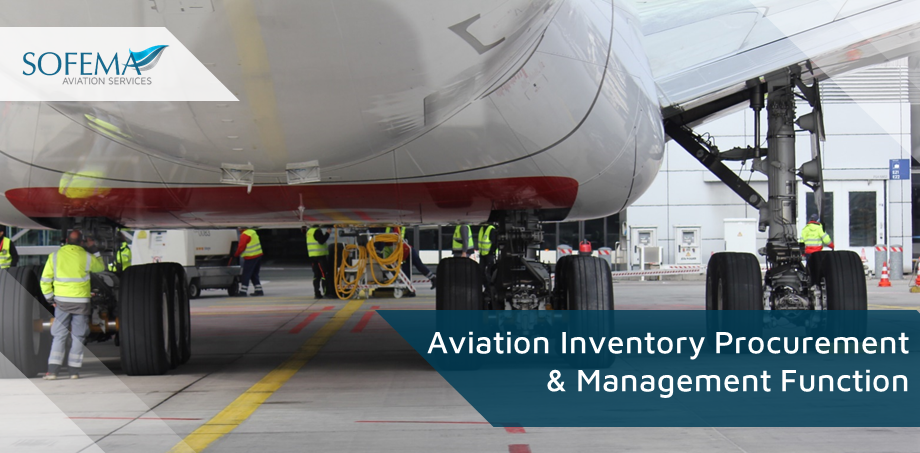Sofema Aviation Services (SAS) www.sassofia.com considers the key features of a successful Aviation Inventory Procurement & Management Function
Introduction
Aviation maintenance parts management involves the effective management of spare parts, components, and supplies needed for maintaining and repairing aircraft.
The aviation industry is heavily regulated, and parts management must comply with regulations set by aviation authorities including the FAA (Federal Aviation Administration) or EASA (European Union Aviation Safety Agency).
Given the critical nature of aviation components, stringent quality control is essential, this includes inspections to ensure all parts meet specific standards. Compliance includes ensuring parts are certified, properly documented, and traceable.
Aviation parts can be expensive. Effective cost management strategies are important to control expenses without compromising on quality or compliance.
- This can include strategies like bulk purchasing, long-term contracts with suppliers, or investing in repair rather than replacement where feasible.
- The goal is to ensure that the right parts are available at the right time and place, without causing delays or compromising safety.
- Balancing inventory levels is crucial. Overstocking can be costly while understocking can lead to aircraft downtime.
- Advanced inventory management systems are used to forecast demand and manage stock levels efficiently.
Supply Chain Management (SCM)
Taken together SCM as well as effective contracts are critical aspects of modern business operations. These two elements are deeply interconnected and play vital roles in ensuring efficiency, reliability, and profitability.
- SCM is the oversight of materials, information, and finances as they move from supplier to manufacturer to wholesaler to retailer to consumer.
- It involves coordinating and integrating these flows both within and among companies.
- The main goal is to provide the right products in the right quantities, to the right locations, all at the right time.
- The aviation supply chain is crucial for providing high-quality, certified parts for aircraft. Faulty or counterfeit parts can lead to catastrophic failures. Strict quality control and certification processes are essential.
- The industry’s continuous focus on improving supply chain management, adhering to regulatory standards, and embracing technological advancements plays a vital role in maintaining the remarkable safety record of commercial aviation.
Supply Chain Contract Preparation:
- Cost-Benefit Analysis: Conducting thorough cost-benefit analyses for procurement decisions to ensure financial viability and optimal resource allocation.
- Clarity and Precision: Contracts must clearly define the scope of work, delivery timelines, pricing, and quality standards.
- Flexibility and Adaptability: Considering the dynamic nature of supply chains, contracts should allow for some degree of flexibility to adapt to unforeseen changes.
- Risk Management: Allocation of risks between parties should be fair and clear. This includes provisions for delays, damages, and non-compliance.
- Performance Metrics and Compliance: Including specific performance indicators helps in monitoring compliance and overall performance.
- Inventory Optimization: Implementing inventory optimization techniques to maintain an optimal balance between stock availability and cost.
Tools and Software Considerations:
- Familiarity with software and tools used in inventory management, procurement, and compliance tracking is essential.
- This can include ERP (Enterprise Resource Planning) systems, database management tools, and specific aviation maintenance software.
- Leveraging technology such as RFID tracking, and data analytics for efficient and accurate inventory control.
Suspect Parts
The use of Suspect or counterfeit aircraft parts is a significant concern in aviation, as they can lead to catastrophic failures. While it’s often challenging to directly link aircraft accidents to counterfeit parts due to the complexity of investigations and the numerous factors involved in accidents, there have been several incidents where bogus parts were either directly implicated or suspected to have played a role.
Sept. 8, 1989, Partnair Flight 394 carrying 55 people from Oslo to Hamburg crashed into the sea, killing everyone on board. Investigators later determined that counterfeit bolts and brackets had caused the tail section of the Convair CV-580 turboprop to vibrate violently and eventually tear loose.
TAM Transportes Aéreos Regionais Flight 402 (1996): This Brazilian airline crash shortly after takeoff was initially linked to a faulty thrust reverser. Investigations later revealed that parts used in the aircraft’s engine control system were not up to the required standards
Ensuring Regulatory Compliance
- EASA sets stringent standards for aviation safety in Europe, including the management of aircraft parts. These regulations ensure that all parts used in aircraft maintenance are of the highest quality and are suitable for use.
- Ensuring strict adherence to EASA regulations in all aspects of inventory management to avoid penalties and maintain operational legitimacy.
- Implementing robust risk management strategies to mitigate risks associated with inventory handling, such as obsolescence, damage, or supply chain disruptions.
Next Steps
Follow this link to our Library to find & Download related documents for Free.
Sofema Aviation Services www.sassofia.com and www.sofemaonline.com provides EASA Compliant Regulatory Training and Vocational Courses for the Aviation Supply Chain. Please see the websites for more information or email team@sassofia.com
Tags:
Aviation Industry, Regulatory Compliance, EASA compliant regulatory training, SAS blogs, Aviation Supply Chain, risk management strategies., EASA (European Union Aviation Safety Agency), Aviation Inventory Procurement, Management Function, parts management, spare parts, FAA (Federal Aviation Administration), Enterprise Resource Planning, operational legitimacy, Vocational Courses




